可对7种气体同时检测的TY2000-C气体检测仪
- 格式:doc
- 大小:50.50 KB
- 文档页数:2
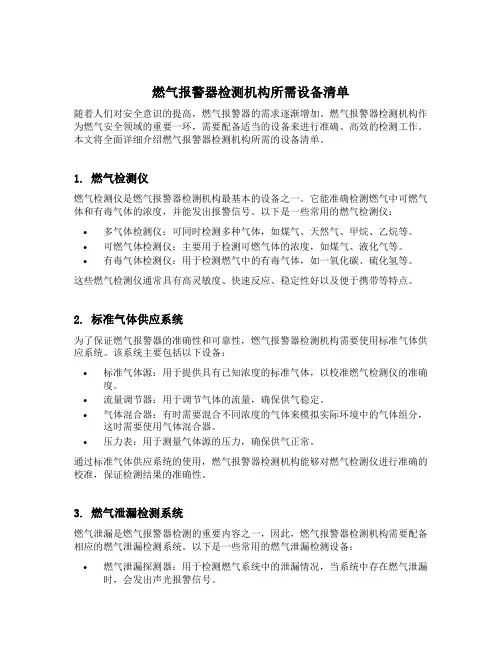
燃气报警器检测机构所需设备清单随着人们对安全意识的提高,燃气报警器的需求逐渐增加。
燃气报警器检测机构作为燃气安全领域的重要一环,需要配备适当的设备来进行准确、高效的检测工作。
本文将全面详细介绍燃气报警器检测机构所需的设备清单。
1. 燃气检测仪燃气检测仪是燃气报警器检测机构最基本的设备之一。
它能准确检测燃气中可燃气体和有毒气体的浓度,并能发出报警信号。
以下是一些常用的燃气检测仪:•多气体检测仪:可同时检测多种气体,如煤气、天然气、甲烷、乙烷等。
•可燃气体检测仪:主要用于检测可燃气体的浓度,如煤气、液化气等。
•有毒气体检测仪:用于检测燃气中的有毒气体,如一氧化碳、硫化氢等。
这些燃气检测仪通常具有高灵敏度、快速反应、稳定性好以及便于携带等特点。
2. 标准气体供应系统为了保证燃气报警器的准确性和可靠性,燃气报警器检测机构需要使用标准气体供应系统。
该系统主要包括以下设备:•标准气体源:用于提供具有已知浓度的标准气体,以校准燃气检测仪的准确度。
•流量调节器:用于调节气体的流量,确保供气稳定。
•气体混合器:有时需要混合不同浓度的气体来模拟实际环境中的气体组分,这时需要使用气体混合器。
•压力表:用于测量气体源的压力,确保供气正常。
通过标准气体供应系统的使用,燃气报警器检测机构能够对燃气检测仪进行准确的校准,保证检测结果的准确性。
3. 燃气泄漏检测系统燃气泄漏是燃气报警器检测的重要内容之一,因此,燃气报警器检测机构需要配备相应的燃气泄漏检测系统。
以下是一些常用的燃气泄漏检测设备:•燃气泄漏探测器:用于检测燃气系统中的泄漏情况,当系统中存在燃气泄漏时,会发出声光报警信号。
•热成像仪:通过测量热辐射,能够快速检测出可能存在的燃气泄漏点,具有高效、准确的特点。
这些设备能够快速、准确地检测燃气系统中的泄漏情况,发现潜在的安全隐患。
在燃气泄漏检测方面,燃气报警器检测机构发挥着重要的作用。
4. 燃气漏气检测仪燃气漏气检测仪是一种专门用于检测燃气管道中的泄漏的仪器。
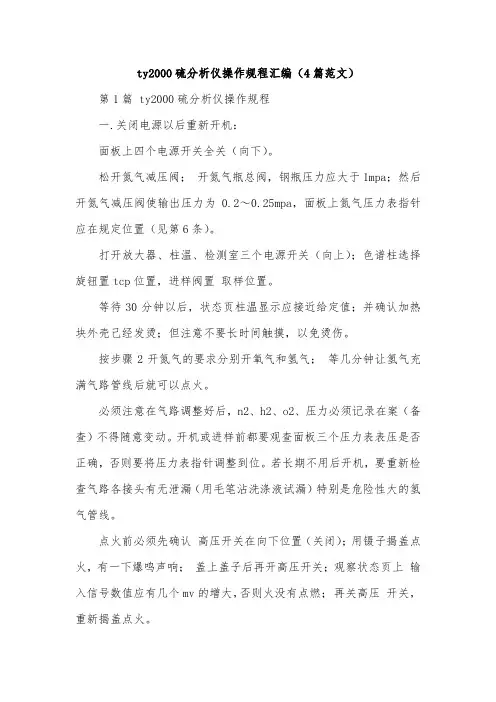
ty2000硫分析仪操作规程汇编(4篇范文)第1篇 ty2000硫分析仪操作规程一.关闭电源以后重新开机:面板上四个电源开关全关(向下)。
松开氮气减压阀;开氮气瓶总阀,钢瓶压力应大于1mpa;然后开氮气减压阀使输出压力为0.2~0.25mpa,面板上氮气压力表指针应在规定位置(见第6条)。
打开放大器、柱温、检测室三个电源开关(向上);色谱柱选择旋钮置tcp位置,进样阀置取样位置。
等待30分钟以后,状态页柱温显示应接近给定值;并确认加热块外壳己经发烫;但注意不要长时间触摸,以免烫伤。
按步骤2开氮气的要求分别开氧气和氢气;等几分钟让氢气充满气路管线后就可以点火。
必须注意在气路调整好后,n2、h2、o2、压力必须记录在案(备查)不得随意变动。
开机或进样前都要观查面板三个压力表表压是否正确,否则要将压力表指针调整到位。
若长期不用后开机,要重新检查气路各接头有无泄漏(用毛笔沾洗涤液试漏)特别是危险性大的氢气管线。
点火前必须先确认高压开关在向下位置(关闭);用镊子揭盖点火,有一下爆鸣声响;盖上盖子后再开高压开关;观察状态页上输入信号数值应有几个mv的增大,否则火没有点燃;再关高压开关,重新揭盖点火。
以后如果要检查是否熄火,或判断检测器是否正常都通过开和关高压开关并观察输入信号的变化来进行。
慢慢调细调电位器旋钮,分几次把输入信号数值调到到0.3mv 左右。
按基线键显示信号曲线,待基线稳定后就可以进样分析。
二.关机如果只是暂时不进样,只关高压开关(向下)并把色谱柱选择在tcp位置,进样阀置取样位置。
其它的特别是三只压力旋钮不要随意改变。
长时间不用停机:a、先关高压开关,再关柱温和放大器开关,色谱柱选择在tcp 位置,进样阀置取样位置。
b、关氢气瓶总阀,松开氢气瓶减压阀。
c、关氧气瓶总阀,松开氧气瓶减压阀。
d、等待面板氢气和氧气压力表指示为零(即燃烧室已经熄火)后,关检测室开关。
e、关氮气瓶总阀,松开氮气瓶减压阀。
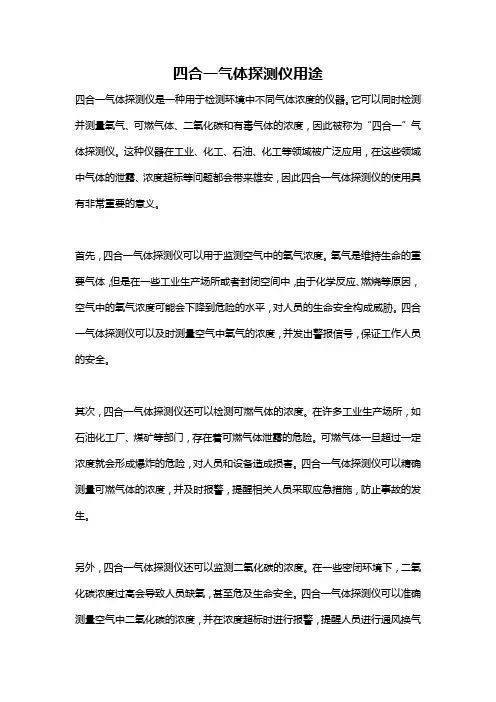
四合一气体探测仪用途四合一气体探测仪是一种用于检测环境中不同气体浓度的仪器。
它可以同时检测并测量氧气、可燃气体、二氧化碳和有毒气体的浓度,因此被称为“四合一”气体探测仪。
这种仪器在工业、化工、石油、化工等领域被广泛应用,在这些领域中气体的泄露、浓度超标等问题都会带来雄安,因此四合一气体探测仪的使用具有非常重要的意义。
首先,四合一气体探测仪可以用于监测空气中的氧气浓度。
氧气是维持生命的重要气体,但是在一些工业生产场所或者封闭空间中,由于化学反应、燃烧等原因,空气中的氧气浓度可能会下降到危险的水平,对人员的生命安全构成威胁。
四合一气体探测仪可以及时测量空气中氧气的浓度,并发出警报信号,保证工作人员的安全。
其次,四合一气体探测仪还可以检测可燃气体的浓度。
在许多工业生产场所,如石油化工厂、煤矿等部门,存在着可燃气体泄露的危险。
可燃气体一旦超过一定浓度就会形成爆炸的危险,对人员和设备造成损害。
四合一气体探测仪可以精确测量可燃气体的浓度,并及时报警,提醒相关人员采取应急措施,防止事故的发生。
另外,四合一气体探测仪还可以监测二氧化碳的浓度。
在一些密闭环境下,二氧化碳浓度过高会导致人员缺氧,甚至危及生命安全。
四合一气体探测仪可以准确测量空气中二氧化碳的浓度,并在浓度超标时进行报警,提醒人员进行通风换气等措施,确保工作环境的安全。
最后,四合一气体探测仪还具有检测有毒气体浓度的功能。
在一些化工生产、实验室等场所,会产生一些有毒气体,如硫化氢、氨气等,这些气体一旦泄露会对人员的健康造成严重威胁。
四合一气体探测仪可以及时发现有毒气体的存在,并发出警报,让相关人员采取紧急措施,避免中毒事故的发生。
综上所述,四合一气体探测仪主要用途是检测环境中氧气、可燃气体、二氧化碳和有毒气体的浓度,以保障工作场所的安全。
它的使用可以有效预防工业生产中常见的气体事故,保护人员的生命安全和财产安全。
因此,四合一气体探测仪在工业领域具有非常重要的意义,对于提高安全生产水平、降低事故发生率具有重要的作用。

产品介绍:随着工业的迅速发展,人类接触有害气体的场合越来越多,由此造成对人类本身的危害也越来越大,一次次的中毒事故,使人们清醒的认识到在发展工业的同时保护人类自身安全的重要性。
因此各种有害气体报警仪渐渐成为工业安全生产中必不可少的防护设备。
QB2000T系列固定式氧气检测探测器(以下简称探测器),是我公司采用先进的电化学传感器,结合多年来从事气体检测探头研制的经验而开发出的新产品。
它可以广泛应用于冶金、石油、石化、化工、轻工、焦化、市政、煤气、制药、污水处理及许多特殊行业和领域。
可分别检测多种气体,如:可燃性气体和O2、H2S、CO、HCN、NO2、SO2、NH3、HCL、CL2、H2等十多种有毒气体。
4~20mA标准信号输出,RS485_Modbus_RTU,可远距离传输,可直接进入DCS系统,探头具有灵敏度高、反应迅速、寿命长、极化时间短等特点,处于国内同类产品领先水平。
功能特点:◆仪器采用先进的16位超低功耗嵌入式微控制器◆用户可自行设置高低报警点◆重要操作需密码验证,有效防止误操作◆标准三线制4-20mA电流信号输出,兼容现有报警控制单元或DCS(分散控制系统)◆RS485隔离数字信号与工厂上位机连接◆LED数码管显示或LCD液晶显示◆传感器故障自动识别并现场显示,同时输出相应故障电流信号◆-40~+70℃温度数字自动跟踪补偿,保证测量准确性◆标准三按键实现单人单点现场维护◆现场两级光报警,继电器输出(外接声光报警器或驱动排风等外设设备)◆探测器可以更换同类型传感器,也可以更换不同气体种类的传感器,不同量程传感器模块,探测器自动识别,无需标定技术参数:◆测量量程:见附表◆工作电压:24VDC±15%◆信号输出:4~20mA线性电流输出;或RS485信号输出◆响应时间:T90 小于30秒◆恢复时间:小于30秒◆分辨率:详见选型表◆精度:±3%F.S◆显示模式:LED数码管显示(可选液晶显示)◆环境温度:-30~+60℃(具体依据传感器参数)◆环境湿度:10-95% R.H.(无凝露)◆防爆等级:Exd IICT6(隔爆应用);ExiaIICT4(本安应用)◆防护等级:IP66◆安装螺纹:M20×1.5、G1/2◆使用电缆:3×1.5mm2或4×2.5mm2屏蔽电缆传输距离:≤1000m◆尺寸重量:160mm(L)140mm(W)85mm(H) 约1.5kg 检测气体种类表。

危险化学品安全监测技术及设备介绍危险化学品的安全监测是保障公众和环境安全的重要环节。
随着化学工业的快速发展,危险化学品的种类和使用范围不断扩大,对其安全监测技术和设备提出了更高的要求。
本文将介绍一些常见的危险化学品安全监测技术及设备。
一、气体检测仪器气体是危险化学品中常见的一种形态,因此气体检测仪器是危险化学品安全监测的重要工具之一。
气体检测仪器主要用于检测空气中的有害气体浓度,如有毒气体、可燃气体等。
常见的气体检测仪器包括气体检测仪、气体泄漏探测器等。
这些仪器可以通过传感器对气体浓度进行实时监测,并发出警报以提醒人们采取相应的安全措施。
二、液体检测仪器除了气体,液体也是危险化学品中常见的一种形态。
液体检测仪器主要用于检测液体中的有害成分浓度,如有毒物质、腐蚀性物质等。
常见的液体检测仪器包括液体浓度计、液体分析仪等。
这些仪器可以通过化学分析的方法,准确地测量液体中各种成分的浓度,从而判断其是否符合安全标准。
三、辐射检测仪器辐射是危险化学品中常见的一种危害形式,因此辐射检测仪器也是危险化学品安全监测的重要工具之一。
辐射检测仪器主要用于检测环境中的辐射水平,如电离辐射、非电离辐射等。
常见的辐射检测仪器包括辐射剂量仪、辐射计等。
这些仪器可以通过测量辐射水平的强度和剂量,判断环境是否超过了安全标准,并及时采取相应的防护措施。
四、火灾监测仪器火灾是危险化学品可能引发的一种重大安全事故,因此火灾监测仪器在危险化学品安全监测中也起着重要的作用。
火灾监测仪器主要用于检测火灾的早期迹象,如烟雾、温度升高等。
常见的火灾监测仪器包括烟雾探测器、温度传感器等。
这些仪器可以及时发出警报,提醒人们采取紧急疏散和灭火措施,从而减少火灾带来的损失。
综上所述,危险化学品安全监测技术及设备在保障公众和环境安全方面起着重要的作用。
气体检测仪器、液体检测仪器、辐射检测仪器和火灾监测仪器等都是常见的危险化学品安全监测工具。
通过这些仪器的使用,可以及时发现和预防危险化学品可能带来的安全隐患,保障人们的生命财产安全。
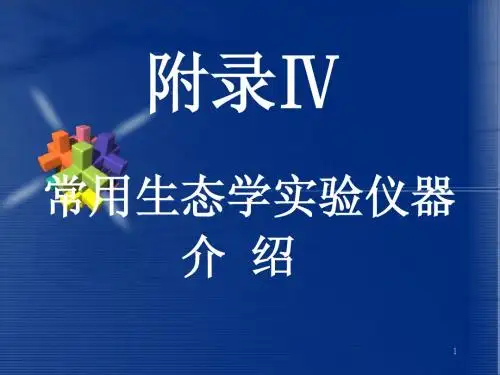
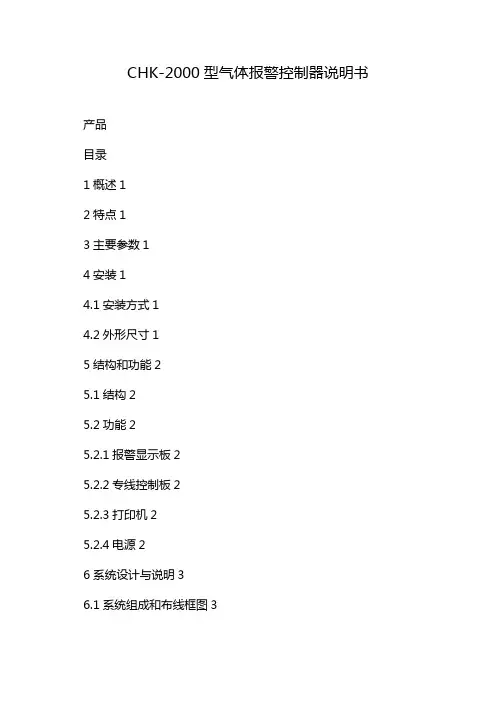
CHK-2000型气体报警控制器说明书产品目录1概述12特点13主要参数14安装14.1安装方式14.2外形尺寸15结构和功能25.1结构25.2功能25.2.1报警显示板25.2.2专线控制板25.2.3打印机25.2.4电源26系统设计与说明36.1系统组成和布线框图36.2系统布线和设计要求3 7现场调试步骤37.1绝缘电阻测量37.2编址单元编址37.3控制器静态测量3 7.4控制器空载通电检测3 7.5编制单元登记37.6联动功能测试38操作使用说明48.1正常监视状态48.2液晶屏亮度调节4 8.3故障48.4火警48.5联动48.6菜单操作48.6.1联动48.6.2设置58.6.2.1日期与时钟58.6.2.2自动登记68.6.2.3手动登记68.6.2.4部件隔离68.6.2.5联动编程68.6.2.6开关打印机6 8.6.2.7控制检测68.6.2.8联动控制方式7 8.6.2.9清除操作78.6.2.10汉字注释输入7 8.6.3查询78.6.3.1登记地址查询7 8.6.3.2隔离地址查询7 8.6.3.3联动编程查询7 8.6.3.4控制检测查询8 8.6.3.5当前故障查询8 8.6.3.6汉字注释查询8 8.6.3.7历史记录88.6.4测试88.6.4.1部件状态信号9 8.6.4.2模拟量曲线98.6.4.3回路信号浏览98.6.4.4地址类型状态98.6.4.5控制器自检99联动逻辑编程语句格式910使用与维护1011运输、储存1012随机附件1013其它101概述CHK-2000型可燃气体报警控制器(以下简称控制器)是我公司为了满足燃气市场的不断发展需求而研制开发的新产品。
它是二总线可燃气体报警控制器,集气体泄漏报警和联动控制于一体,可以与我公司生产的防爆型燃气探测器及各种模块等设备组成智能化的总线型可燃气体报警控制系统。
该系统比较适用于中、小型建筑面积的火情监测和控制。
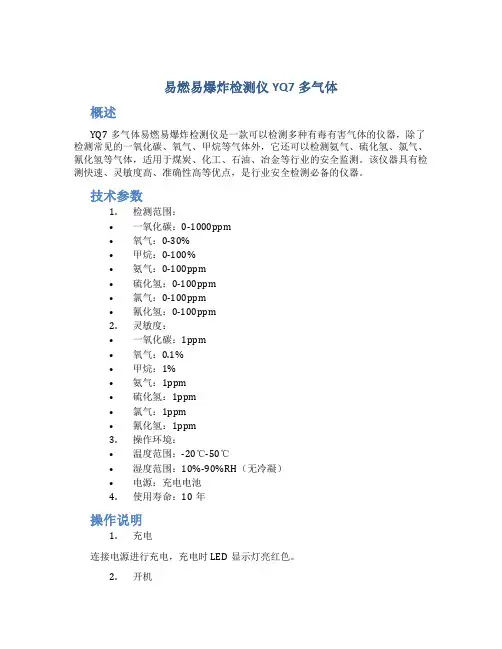
易燃易爆炸检测仪YQ7多气体概述YQ7多气体易燃易爆炸检测仪是一款可以检测多种有毒有害气体的仪器,除了检测常见的一氧化碳、氧气、甲烷等气体外,它还可以检测氨气、硫化氢、氯气、氰化氢等气体,适用于煤炭、化工、石油、冶金等行业的安全监测。
该仪器具有检测快速、灵敏度高、准确性高等优点,是行业安全检测必备的仪器。
技术参数1.检测范围:•一氧化碳:0-1000ppm•氧气:0-30%•甲烷:0-100%•氨气:0-100ppm•硫化氢:0-100ppm•氯气:0-100ppm•氰化氢:0-100ppm2.灵敏度:•一氧化碳:1ppm•氧气:0.1%•甲烷:1%•氨气:1ppm•硫化氢:1ppm•氯气:1ppm•氰化氢:1ppm3.操作环境:•温度范围:-20℃-50℃•湿度范围:10%-90%RH(无冷凝)•电源:充电电池4.使用寿命:10年操作说明1.充电连接电源进行充电,充电时LED显示灯亮红色。
2.开机长按开关键2秒,等待启动,仪器启动时LED显示灯亮蓝色,检测完成后仪器会自动关闭。
3.检测选择需要检测的气体按钮,检测时LED显示灯亮绿色,检测完成后LED显示灯熄灭,仪器会自动关闭。
4.报警若检测出有害气体浓度超过预设值,仪器会自动发出声光报警。
注意事项1.使用前请先阅读说明书,必须按照说明书操作。
2.仪器需要进行定期校准和维护,以确保检测准确。
3.使用过程中若有异常情况请及时停止使用,并联系专业人员进行处理。
结语YQ7多气体易燃易爆炸检测仪是一款实用的安全监测仪器,其高灵敏度、高准确性的检测功能,能够为行业安全生产提供有效的保障。
但仪器必须经过规范的使用和维护,方能充分发挥其作用,推动行业的安全监测事业发展。
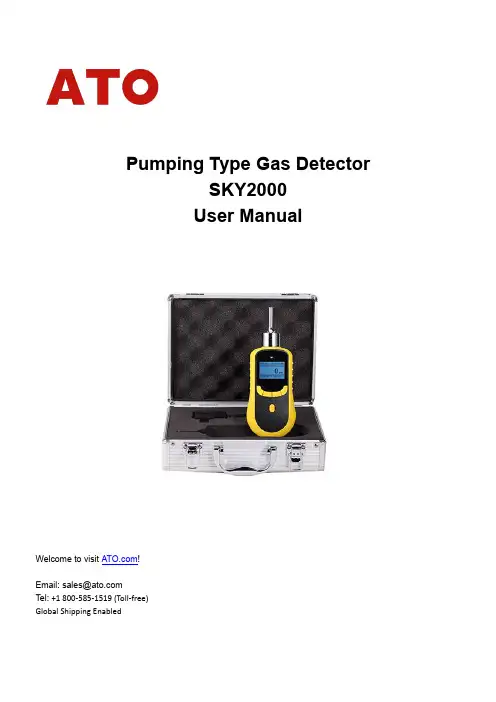
Pumping Type Gas DetectorSKY2000User ManualWelcome to visit !Email:*************Tel: +1 800-585-1519 (Toll-free)Global Shipping Enabled*** Thanks for purchasing our product. Please read the user manual carefully before using. *** Keys Operation:Turn on/off: long press for 3s to turn on/off the device, short press to confirm or save data.Menu: in detection mode, press this button to enter into parameter setting mode, and in parameter setting mode, press this button to move the cursor.Plus: in parameter setting mode, short press it to select items upward or add value. Long press for 3 seconds to turn on/off alarm function quickly.Minus: in parameter setting mode, short press it to select items downward or decrease value. Long press for 3 seconds to turn on/off air pump quickly.Exit: in parameter setting mode, short press it to go back to previous menu. Long press to shift the gas concentration unit quickly.Power On / OffPut the detector in clean air, and press the “ON/OFF” for three seconds, the detector will be turned on and the pump will start to work. The screen displays the following interface successively: Brand and Logo, main parameter interface, initialing countdown. The countdown would be 60 or 120 seconds, which is to make sure that the sensors are fully activated. After countdown, the device enter normal detection interface.Take the detector out of the detected environment and wait for the data to get down to zero, then press the “ON/OFF” to turn off the detectorZero CalibrationZero calibration must be done in clean air. Better to do once after alarming happens.Press “MENU” to enter parameter setting mode, select the "calibrate zero", and press “ON/OFF” to enter the mode. Observe the value of “real time concentration”. If the reading is not zero and the drifting is too big when the reading is stable, then it is necessary to conduct zero point calibration.Press “ON/OFF”, the real-time concentration will go back to zero, and press ”ESC” to go back to detection mode, gas concentration values also back to zero.Note: Zero calibration of oxygen detector, nitrogen detector and carbon dioxide detector (target gases are component of the air) cannot be done in the air. Only the target point calibration (value of target point concentration is the standard concentration values in the clean air) can be done.Process of Over-range incorrect operationUsers should avoid using gases which exceed the measure range to impact the sensor, because it will affect the lifespan and sensitivity of the sensor, even, "poison" the sensor. If there is any over-range incorrect operation makes the detector displaying an concentration at a large reading, the remedy is to take the device out of the environment immediately and put it in clean air for over half an hour, and then observe the reading, if it keeps going down, then wait until the reading back to zero before powering it off, and do the zero point calibration next time before using it. If the reading maintained at full scale, user should send the device back to manufacturer or agent for repair or replacing the sensor.①— Air Inlet②— Air Outlet③— air chamber of sensor④— LCD⑤— PLUS⑥— MINUS⑦— MENU⑧— ESC⑨— ON/OFF----------------------------------------------------------------------------------------------------------------------------- Note*If detector is used for the gas cylinder detection, considering the high pressure in the cylinder, please use a pressure regulator, and keep it as the below data:Flow rate: 800mL~1L/minutePressure: 0.1MPa or 1Bar*Please put the detector in clean air for about 5 minutes and waiting for the data falling down to normal before turning it off after measurement.Operation InterfaceWhen the detector is turned on completely, the device will enter the detecting interface. The gas type will be showed on the top left, and the time and battery power will be at the right. In the middle, there is the real- time concentration. There will be BEEP-ON at the bottom left, which means the alarm is on. The PUMP-ON at the bottom right, which means the pump is working.Alarm StatusWhen the detected gas concentration is higher than the low alarm value, the alarm sound will be on, yellow light will be flickered.When the detected gas concentration is high than the high alarm value, the alarm sound will be on, red light will be flickered.Alarm SettingPress “Menu”, choose the “Alarm point set”, and start to set the alarm value.There are LOW POINT and HIGH POINT for set, press “MENU” to move the cursor to the value you want to set, and press the “PLUS” or “MINUS” to change the value. After the setting is done, press “ON/OFF” button to save the settings.Low Battery AlarmWhen the battery is low, there will be sound, light low battery alarm. There will be sound and light every 5 seconds to remind the user to charge the device in time. When the battery is used up, the device will be turned off automatically.Restore SettingWhen all the settings are wrong, or users operate the detector in a wrong way, you can restore the detector to factory settings. But if the detector works normally, please don’t operate this setting. In order to avoid wrong setting, password is needed. If you want to restore the detector to factory setting, please contact the supplier.Storage S et tingIn the storage setting, you can set the storage status and the interval. Every time you turn on the detector, the storage status defaults OFF, so you need to set the storage status if you want to record the data.Press MENU, choose the “Storage set”, move the cursor by pressing MENU at the “ENABLE”, press MINUS to change NO to YES.The storage interval can be 5 seconds, 10 seconds, 15 seconds, etc. The highest interval is 1 hour.(* The storage setting only for gas detector with data storage function)View H istory D ataPress the MENU, choose “view history data”. Then at the top is the record total number, and the reminder “PLEASE SELECT”. Now, if you press MINUS, then the record data will be from the first record to the second in turn. If the record number is above 10, and you want to check the specific number, you press the MENU again, then you can input the exact number and check that record(press the MENU to move the cursor, and press the MINUS and PLUS to change the number), press ON/OFF to confirm and then you will see the detailed record.In the detailed record interface, at the top are the record total number and current number. In the middle are the date and time, and the concentration is at the bottom.Erase H istory D ataTo make sure the detector work perfectly and you can check the history data quickly, we suggest you to erase the history data regularly. Press MENU, choose the “Erase ex_flash”, password is needed (the password is 9999), then press ON/OFF, it shows that “erasing”, and when finished, it will turn back to the detecting interface. Target Point CalibrationNote: Calibration needs to be done by professionals and with necessary accessories and standard gas.Prepare the standard gas before starting the target point calibration. In detection mode, press “MENU”, select “calibrate span”, press ON/OFF button to enter. Then you will need to enter password. (If you need password, please contact the manufacturer to get it)After entering the password successfully, press ON/OFF to enter the target point calibration interface, as shown in the picture. The interface will display “concentration”, “set value. The concentration is the result got from the calculation of several internal calibration parameters. The process of calibration is the process to recalculate the internal parameters of the device. The set value is the value need to be entered manually; it should be the concentration of the standard gas to be calibrated. Select the parameter under the current interface, modify its value with “PLUS” and “MINUS” button.The calibration process is as below:1.Connect the detector with standard gas cylinder by hose.2.Enter the target point calibration interface, set the “SET value”as the standard gas concentration.3.Release the standard gas to the detector in a flow rate of500mL/min. The value of “concentration” will become largergradually, and become stable after 30seconds.4.When the value of “concentration” is stable, press the “ON/OFF” button, the value of “concentration” will be same with oralmost same with the “Set value”. The calibration is finished.5.Cut off the standard gas supply. Press “ESC” to go back todetection interface.。
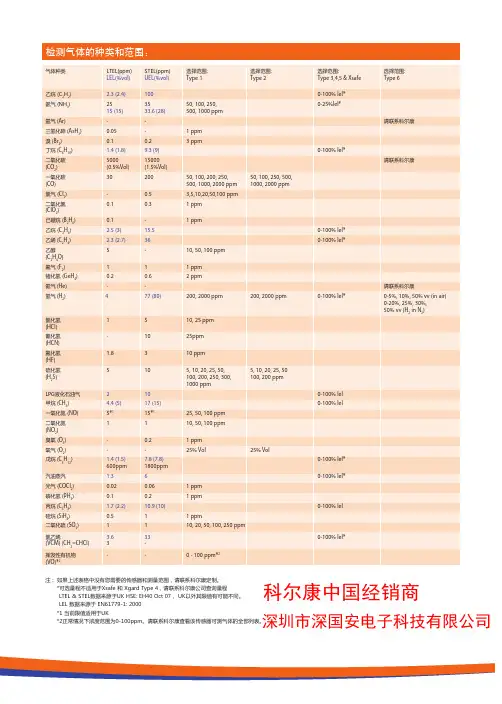
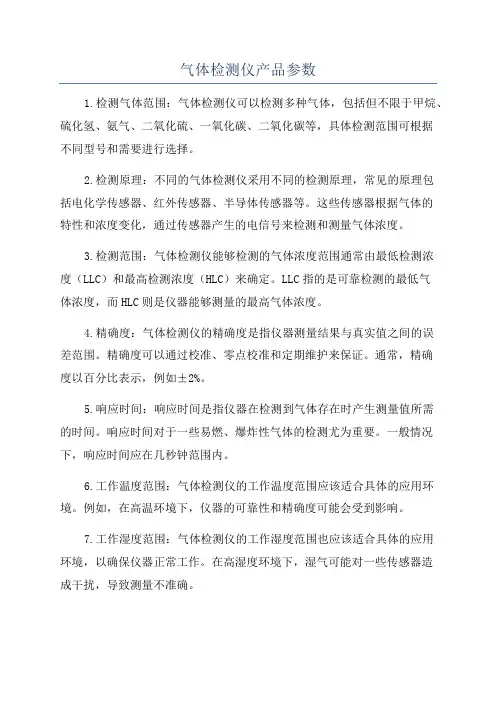
气体检测仪产品参数1.检测气体范围:气体检测仪可以检测多种气体,包括但不限于甲烷、硫化氢、氨气、二氧化硫、一氧化碳、二氧化碳等,具体检测范围可根据不同型号和需要进行选择。
2.检测原理:不同的气体检测仪采用不同的检测原理,常见的原理包括电化学传感器、红外传感器、半导体传感器等。
这些传感器根据气体的特性和浓度变化,通过传感器产生的电信号来检测和测量气体浓度。
3.检测范围:气体检测仪能够检测的气体浓度范围通常由最低检测浓度(LLC)和最高检测浓度(HLC)来确定。
LLC指的是可靠检测的最低气体浓度,而HLC则是仪器能够测量的最高气体浓度。
4.精确度:气体检测仪的精确度是指仪器测量结果与真实值之间的误差范围。
精确度可以通过校准、零点校准和定期维护来保证。
通常,精确度以百分比表示,例如±2%。
5.响应时间:响应时间是指仪器在检测到气体存在时产生测量值所需的时间。
响应时间对于一些易燃、爆炸性气体的检测尤为重要。
一般情况下,响应时间应在几秒钟范围内。
6.工作温度范围:气体检测仪的工作温度范围应该适合具体的应用环境。
例如,在高温环境下,仪器的可靠性和精确度可能会受到影响。
7.工作湿度范围:气体检测仪的工作湿度范围也应该适合具体的应用环境,以确保仪器正常工作。
在高湿度环境下,湿气可能对一些传感器造成干扰,导致测量不准确。
8.电源要求:气体检测仪通常使用可充电电池供电。
电池容量和充电时间是选择气体检测仪时需要考虑的重要因素。
一般情况下,电池容量应能够满足长时间连续工作的需求。
9.显示屏和操作界面:气体检测仪应该配备清晰易操作的显示屏和操作界面,以方便用户查看检测结果和进行操作设置。
显示屏通常会显示检测气体的名称、浓度、单位以及其他相关信息。
10.数据记录和传输:一些气体检测仪具有数据记录和传输功能,可以将检测结果存储在内部存储器中,并通过USB接口或蓝牙等方式将数据传输到计算机或其他设备。
这些是一些常见的气体检测仪产品参数。
TH-2000系列环境空气质量自动监测系统是我公司适应市场需求自主研制开发的高新技术产品,本系统产品主要监测空气TSP、PM10、PM2.5、SO2、NO2、NO、NO X、O3、CO、H2S、NH3等对环境和人体有危害的有毒气体。
可根据客户需求进行自由选配,也可单台设备进行配置。
TH-2000系列环境空气质量自动监测系统由一个中心站和若干个子站组成,子站的数据采集控制系统与中心站的数据处理控制系统通过通讯网络进行数据传输,完成数据采集处理、远程控制等功能,数据在中心站经过数据处理可形成环境空气质量统计报表。
TH-2000系列环境空气自动监测系统是我公司利用国际上先进的光电技术研制、开发出来的最新科技产品。
该系统符合国家对城市环境空气自动监测系统的各项技术指标要求,国产化程度高,具有较强的实用性和理想的性能价格比,可替代同类进口产品,是开展城市环境空气自动监测的理想仪器。
TH-2000系列环境空气自动监测系统由一个中心站和若干个子站构成,因此系统软件将由中心站软件和子站软件两大部分组成,两者有机结合,协调整个监测系统的运行,完成对各种监测仪器的数据采集和远程通讯控制及数据处理,并形成报告。
系统组成大气污染监测仪:包括SO2、NOx(NO、NO2)、CO、O3、空气颗粒物(TSP)、PM10等监测仪(可根据用户需要选配)。
气象仪:可测量风速、风向、温度、相对湿度、大气压力(可根据用户需要选配降雨量、日照等)。
现场校准系统:包括多种标准气体、一台零气发生器、一台仪器标定动态气体发生器。
子站计算机:可连续自动采集大气污染监测仪、气象仪、现场校准的数据及状态信息等。
并进行预处理和贮存,等待中心计算机轮询或指令。
采样集气管:由采样头、总管、支路接头、抽气风机、排气口等组成。
远程数据通讯设备:有线调传或直接使用无线PC卡(支持GPRS或CDMA)。
系统软件TH-2000系统软件的开发立足于基础建设,功能设计上高度浓缩,极大限度减少对操作系统的要求,几乎不依赖于其它应用软件的支持,运行环境要求低,易于安装使用和维护,属绿色环保软件,适宜于长期稳定运行。
TH-2000-C氮氧化物在线监测系统主要应用于气体分析行业,主要检测场合:燃气锅炉尾气监测、污染源在线监测、烟气排放、脱硫脱硝、锅炉尾气、污水管道气体检测分析、高温高湿气体检测分析等。
其主要原理是:采样单元采集现场的烟气或被测气体,预处理单元对气体进行降温、除湿、过滤粉尘,并将被测气体的温度和湿度恒定在一定范围,气体检测单元检测分析被输送过来的气体,在显示屏上实时显示被测气体浓度,并将数据信号向外传输到PLC或者电脑等终端,也可以通过无线GPRS(DTU)或网络传输到各地环保局或云服务器,用户再从服务器读取数据,可以实现全球联网监控分析。
整个过程为自动化处理,不需人为干预处理。
TH-2000-C氮氧化物在线监测系统适用于低粉尘、高温度、高湿度场合的气体检测分析,若被测气体的粉尘含量高,需要选配自动反吹系统或预留反吹接口定期接入压缩空气进行反吹,否则需要定期手动维护清洗粉尘过滤器。
TH-2000-C气体预处理系统内置双级电子冷凝除湿系统和0.5米精细粉尘过滤取样头(法兰安装),采样距离40米,自动降温、自动排水、过滤焦油。
对于易溶于水的气体检测分析和冬天室外结冰环境,防止采样管路结冰,需选择保温和电伴热恒温控制系统。
如果对被测气体的干燥度和洁净度要求很高,请选择
TH-3000系列,含保温和电伴热恒温控制系统、双级高效压缩机水冷除湿系统,可以将气体的露点稳定控制在4℃或5℃。
关于NOX氮氧化物在线监测系统TH-2000-C的检测原理及应用场合的所有内容,逸云天小编就介绍到这里了,除了氮氧化物检测系统之外,逸云天还可提供有毒有害、易燃易爆气体检测报警仪、气体分析仪、气体在线监测预处理系统、TVOC在线监测系统、差分紫外光谱气体分析仪、激光气体分析仪、环保安监气体监测云平台等产品。
可燃气体浓度检测仪可燃气体探测器:可燃气体探测器是对单一或多种可燃气体浓度响应的探测器。
可燃气体探测器有催化型、红外光学型。
目录催化燃烧型气体探测器红外线可燃气体探测器技术特性烷烃类可燃气体探测器可燃气体探测器催化燃烧型气体探测器用以监测四周空气中可燃气体从0~100%LEL范围内的变化。
该传感器采纳催化燃烧技术,传感器可在现场更换。
催化燃烧型传感器对于种类繁多的可燃性气体有敏锐的反应。
该技术对于可燃性气体具有普遍适用性。
传感器经特别设计有防中毒功能,能在多数工业环境中牢靠工作五到十年。
—最坚固的结构—电解法抛光316SS不锈钢结构—100%环氧树脂封装电路—I/O输入输出多层保护(过压,接线错误,抗电磁干扰/抗无线电波干扰)—防水,防腐蚀,防震动—模块化设计、维护便利—模块化设计,即插即用部件—最少的组件(通用设计理念)—快速螺纹拆卸(便于传感器更换)—一体化标定接口技术指标:检测原理:催化燃烧技术量程:0—100%LEL精度:0.5%LEL时:±3%;51—100%LEL时±5%响应时间:T5010sT9030s环境温度:—40℃to75℃环境湿度:0—100%RH(无冷凝)信号输出:4—20mA,RS—485电源输入:11.5—28VDC耗电量:24VDC下2W电气和防爆等级:Class1;Division1;GroupsB,C,D;EXdIICT6 安全认证:CSA/NRTL(美国OSHA认证)质量保证期:传感器:2年(有条件)信号发生器:2年运输包装尺寸:12.5″×9.5″×8″电缆接口:3/4″NPT内螺纹电缆线径与传输距离:RVVP(3*1MM2):1200m;RVVP(3*1.5MM2):2000m;RVVP(3*2.5MM2):4000m;探测器重量/带包装重量:4磅/5磅红外线可燃气体探测器技术特性1、介绍技术红外线可燃气体探测器属于无干扰智能型产品,具有良好的安全性能,操作快捷简便。
多种气体检测仪多种气体检测仪,是对各类有毒有害气体全面检测的仪器。
并可以快捷配置,来对包括CO2在内的传感器的复合式气体进行检测,适用于室内空气质量检测、工业卫生及其他检测领域。
设备既可以作为个人防护仪器、手持式检测仪,也可以用来进行工作区域的连续检测。
目录仪器介绍其它可选附件标准附件技术参数仪器介绍MultiRAEIR是一种可以特别快捷配置包括CO2在内的多至五种传感器的复合式气体检测仪,适用于室内空气质量检测、工业卫生及其他检测领域。
是目前市场上既可检测氧气、可燃气和常规有毒气体,又可使用红外传感器(NDIR)检测CO2、使用光离子化检测器(PID)检测挥发性有机化合物的泵吸式复合气体检测仪,从而供给了对各类有毒有害气体全面检测的方式。
MultiRAEIR的多功能用途使其可以取代多种检测设备,从而节省大量成本并降低培训和维护的费用。
MultiRAEIR将繁锁的技术设备变化为简单的兼备显示和文本功能的便携式检测仪。
既可以作为个人防护仪器、手持式检测仪,也可以用来进行工作区域的连续检测。
其它直接读数:瞬时值(最多五个)*二氧化碳(ppm)*有毒气体(ppm)*氧气(体积百分比)*可燃气(LEL百分比)*挥发性有机物(ppm)全部检测的和值,有毒气体,VOC和CO2的TWA和STEL值,电池电压和关闭电压日期,时间,使用时间和温度LEL/VOC换算(通过校正系数)。
报警模式:90db蜂鸣器及LED闪动指示超标—高端报警:每秒发出三下嘟嘟声并闪亮—底端报警:每秒发出二下嘟嘟声并闪亮—STEL和TWA:每秒发出一下嘟嘟声并闪亮报警锁定:手动设置或自动重置报警测试和低电压或低泵速时,予以报警并显示相应提示信息。
重要特征:*橡胶保护套*可视LED闪动报警*泵:自动防水保护*可选配智能化传感器:CO、H2S、SO2、NO、NO2、Cl2、HCN、NH3、PH3*使用Windows3.1,95,98和NT软件平台或直接从仪器上修改报警程序*开发的4RL红外(NDIR)二氧化碳检测器,辨别率:10ppm*内置采样吸气泵*大屏幕数字显示*针对不同警报情况的多频率报警声和吵杂地区可选遥控振动报警器*锂电池供给10小时连续操作*简便的一键标定*二氧化碳,指定毒气和VOC气体浓度以ppm级连续测量,LEL以(%)百分比浓度测量可选附件硬质运输箱,5米铁氟龙管,灯清洗包可选附件四气体34L气瓶(50%可燃气,20.9%氧气,5000ppm二氧化碳,50ppm 一氧化碳);校正调整器(外接)和管子;34L异丁烯气瓶;校正调整器(内接)和管子;Pro—RAESuit操作软件包,可用于Windows95,98NT;计算机连接电缆标准附件主机及传感器(需指明)运输箱活性炭过滤器(用于CO检测器)校正适配器操作光盘(需指明)操作维护手册橡胶保护套和带夹碱性电池适配器锂离子电池120VAC/DC充电器(需指明)泵附加包括:10个水肼过滤器,3进气管,水肼过滤器接头技术参数检测器:非扩散红外线检测器(CO2),催化检测器(可燃气LEL),电化学传感器(氧气、有毒气体),光离子化检测器(VOCs),10.6eV灯显示:2行16位数字LCD显示弱光或报警状态下自动点亮LED背景灯按键:一键操作,两键编程标定:零点与标准气体两点校正采样泵:内置式采样泵150cc/min数据记录:可存储20,000个数据(64小时,5通道,1分钟间隔),向PC机传输数据,仪器系列号,用户编号、被测地点编号及校准日期。
可对7种气体同时检测的TY2000-C气体检测仪HS32-TY2000-C型复合气体检测仪(七合一)主要用于现场检测环境空气中的有毒有害气体的浓度,应急(泄漏)事故监测、职业卫生场所有毒有害气体检测、石化企业安全检测以及储罐、管道、阀门泄漏检测等。
该仪器可以灵活配置7种不同有毒有害气体传感器。
可配置:可燃气传感器(LEL)、电化学氧气/毒气传感器、光离子化传感器(PID),是目前市场上唯一一款可同时对可燃气、有毒气体、VOC等7种气体进行检测的检测仪。
TY2000-C型复合气体检测仪(七合一)主要用于现场检测环境空气中的有毒有害气体的浓度,应急(泄漏)事故监测、职业卫生场所有毒有害气体检测、石化企业安全检测以及储罐、管道、阀门泄漏检测等。
主要特点◆可以同时配置包括PID在内的7种气体传感器◆采用自发光OLED屏显示,低温(-30℃)及低可见度下清晰显示◆可外接MH4010传感器多点线性自校准系统(校准比0-100%)◆可外接MH2000气象参数(风速,风向,温度,湿度,现场大气压等)测量,建立现场污染扩散模型(选配)◆可同时检测可燃气、氧气、有毒气体、挥发性有机化合物◆可连接GPS定位系统,快速查清污染泄露源点位准确坐标◆内置强力采样泵,外置可弯曲采样管,低流量自检报警◆内置大容量镍氢电池,工作时间长◆声光报警,报警值用户可自设◆海量储存,可保存30000组测量数据◆性能稳定可靠、操作使用简便技术指标精度:取决于传感器,一般为量程的±5%稳定性:传感器量程的5%重复性:传感器量程的2%电池:可充电镍氢电池,4.8V 2000mAh充电时间:4小时工作时间:可连续工作10小时采样方式:泵吸式泵流量:(200 ~400)ml/min声音报警:100db蜂鸣器可视报警:OLED闪动指示超出限值、电池电压低数据采集:30000组数据通讯:通过SD卡导出保存数据,再由计算机直接读出(可选)校正:多点线性校正温度:-25℃~+55℃湿度:0~95% RH重量:约0.6kg尺寸:(201×116×39)mm传感器信息表 *(本只表适用于TY2000-C型复合气体检测仪)感器名称化学式参数范围分辨率氧气O20–30%0.1%氯气Cl20–10/50 ppm0.1ppm 一氧化氮NO0–250 ppm0.1/1ppm 二氧化氮NO20–20 ppm0.1 ppm 二氧化硫SO20–20ppm0.1 ppm 一氧化碳CO0–500 ppm 1 ppm氨气NH30–100 ppm0.1/1 ppm 氢气H20–1000 ppm 1 ppm硫化氢H2S0–100 ppm0.1 ppm 氰化氢HCN0–30 ppm0.1 ppm 磷化氢PH30–20/1000 ppm0.1/1 ppm 甲烷CH40–100% LEL1% LEL 环氧乙烷(ETO)C2H4O0–100ppm0.1 ppm 光气COCl20–1 ppm0.01 ppm 可燃气体--0-100% LEL1% LEL PID光离子检测器VOC0-10000ppm0.1/1 ppm执行标准Q/02TZD 001-2007《气体检测仪企业标准》GB12358-2006《作业场所环境气体检测报警仪通用技术要求应用领域※危险和应急事故现场※石化/炼油等化工企业※密闭空间非防爆场合※发电厂※纸浆和造纸厂※废品回收站※海洋及近海的井下作业。
可对7种气体同时检测的TY2000-C气体检测仪
HS32-TY2000-C型复合气体检测仪(七合一)主要用于现场检测环境空气中的有毒有害气体的浓度,应急(泄漏)事故监测、职业卫生场所有毒有害气体检测、石化企业安全检测以及储罐、管道、阀门泄漏检测等。
该仪器可以灵活配置7种不同有毒有害气体传感器。
可配置:可燃气传感器(LEL)、电化学氧气/毒气传感器、光离子化传感器(PID),是目前市场上唯一一款可同时对可燃气、有毒气体、VOC等7种气体进行检测的检测仪。
TY2000-C型复合气体检测仪(七合一)主要用于现场检测环境空气中的有毒有害气体的浓度,应急(泄漏)事故监测、职业卫生场所有毒有害气体检测、石化企业安全检测以及储罐、管道、阀门泄漏检测等。
主要特点
◆可以同时配置包括PID在内的7种气体传感器
◆采用自发光OLED屏显示,低温(-30℃)及低可见度下清晰显示
◆可外接MH4010传感器多点线性自校准系统(校准比0-100%)
◆可外接MH2000气象参数(风速,风向,温度,湿度,现场大气压等)测量,建立现场污染扩散模型(选配)
◆可同时检测可燃气、氧气、有毒气体、挥发性有机化合物
◆可连接GPS定位系统,快速查清污染泄露源点位准确坐标
◆内置强力采样泵,外置可弯曲采样管,低流量自检报警
◆内置大容量镍氢电池,工作时间长
◆声光报警,报警值用户可自设
◆海量储存,可保存30000组测量数据
◆性能稳定可靠、操作使用简便
技术指标
精度:取决于传感器,一般为量程的±5%
稳定性:传感器量程的5%
重复性:传感器量程的2%
电池:可充电镍氢电池,4.8V 2000mAh
充电时间:4小时
工作时间:可连续工作10小时
采样方式:泵吸式
泵流量:(200 ~400)ml/min
声音报警:100db蜂鸣器
可视报警:OLED闪动指示超出限值、电池电压低
数据采集:30000组数据
通讯:通过SD卡导出保存数据,再由计算机直接读出(可选)
校正:多点线性校正
温度:-25℃~+55℃
湿度:0~95% RH
重量:约0.6kg
尺寸:(201×116×39)mm
传感器信息表 *(本只表适用于TY2000-C型复合气体检测仪)
感器名称化学式参数范围分辨率
氧气O20–30%0.1%氯气Cl20–10/50 ppm0.1ppm 一氧化氮NO0–250 ppm0.1/1ppm 二氧化氮NO20–20 ppm0.1 ppm 二氧化硫SO20–20ppm0.1 ppm 一氧化碳CO0–500 ppm 1 ppm 氨气NH30–100 ppm0.1/1 ppm 氢气H20–1000 ppm 1 ppm 硫化氢H2S0–100 ppm0.1 ppm 氰化氢HCN0–30 ppm0.1 ppm 磷化氢PH30–20/1000 ppm0.1/1 ppm 甲烷CH40–100% LEL1% LEL 环氧乙烷(ETO)C2H4O0–100ppm0.1 ppm 光气COCl20–1 ppm0.01 ppm 可燃气体--0-100% LEL1% LEL PID光离子检测器VOC0-10000ppm0.1/1 ppm
执行标准
Q/02TZD 001-2007《气体检测仪企业标准》
GB12358-2006《作业场所环境气体检测报警仪通用技术要求
应用领域
※危险和应急事故现场
※石化/炼油等化工企业
※密闭空间非防爆场合
※发电厂
※纸浆和造纸厂
※废品回收站
※海洋及近海的井下作业。